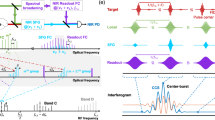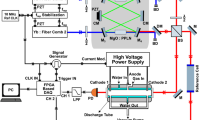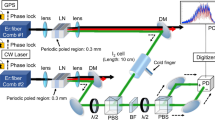Abstract
Mid-infrared dual-comb spectroscopy has the potential to supplant conventional Fourier-transform spectroscopy in applications requiring high resolution, accuracy, signal-to-noise ratio and speed. Until now, mid-infrared dual-comb spectroscopy has been limited to narrow optical bandwidths or low signal-to-noise ratios. Using digital signal processing and broadband frequency conversion in waveguides, we demonstrate a mid-infrared dual-comb spectrometer covering 2.6 to 5.2 µm with comb-tooth resolution, sub-MHz frequency precision and accuracy, and a spectral signal-to-noise ratio as high as 6,500. As a demonstration, we measure the highly structured, broadband cross-section of propane from 2,840 to 3,040 cm−1, the complex phase/amplitude spectra of carbonyl sulfide from 2,000 to 2,100 cm−1, and of a methane, acetylene and ethane mixture from 2,860 to 3,400 cm−1. The combination of broad bandwidth, comb-mode resolution and high brightness will enable accurate mid-infrared spectroscopy in precision laboratory experiments and non-laboratory applications including open-path atmospheric gas sensing, process monitoring and combustion.
This is a preview of subscription content, access via your institution
Access options
Access Nature and 54 other Nature Portfolio journals
Get Nature+, our best-value online-access subscription
$29.99 / 30 days
cancel any time
Subscribe to this journal
Receive 12 print issues and online access
$209.00 per year
only $17.42 per issue
Buy this article
- Purchase on Springer Link
- Instant access to full article PDF
Prices may be subject to local taxes which are calculated during checkout






Similar content being viewed by others
References
Coddington, I., Newbury, N. & Swann, W. Dual-comb spectroscopy. Optica 3, 414–426 (2016).
Ideguchi, T. Dual-comb spectroscopy. Opt. Photon. News 28, 32–39 (2017).
Boudreau, S., Levasseur, S., Perilla, C., Roy, S. & Genest, J. Chemical detection with hyperspectral lidar using dual frequency combs. Opt. Express 21, 7411–7418 (2013).
Schroeder, P. J. et al. Dual frequency comb laser absorption spectroscopy in a 16 MW gas turbine exhaust. Proc. Combust. Inst. 36, 4565–4573 (2017).
Waxman, E. M. et al. Intercomparison of open-path trace gas measurements with two dual-frequency-comb spectrometers. Atmos. Meas. Tech. 10, 3295–3311 (2017).
Cossel, K. C. et al. Open-path dual-comb spectroscopy to an airborne retroreflector. Optica 4, 724–728 (2017).
Roy, J., Deschênes, J.-D., Potvin, S. & Genest, J. Continuous real-time correction and averaging for frequency comb interferometry. Opt. Express 20, 21932–21939 (2012).
Zolot, A. M. et al. Direct-comb molecular spectroscopy with accurate, resolved comb teeth over 43 THz. Opt. Lett. 37, 638–640 (2012).
Ideguchi, T., Poisson, A., Guelachvili, G., Picqué, N. & Hänsch, T. W. Adaptive real-time dual-comb spectroscopy. Nat. Commun. 5, 3375 (2014).
Okubo, S. et al. Ultra-broadband dual-comb spectroscopy across 1.0–1.9 µm. Appl. Phys. Express 8, 082402 (2015).
Schliesser, A., Brehm, M., Keilmann, F. & van der Weide, D. Frequency-comb infrared spectrometer for rapid, remote chemical sensing. Opt. Express 13, 9029–9038 (2005).
Bernhardt, B. et al. Mid-infrared dual-comb spectroscopy with 2.4 μm Cr2+:ZnSe femtosecond lasers. Appl. Phys. B 100, 3–8 (2010).
Baumann, E. et al. Spectroscopy of the methane ν 3 band with an accurate midinfrared coherent dual-comb spectrometer. Phys. Rev. A 84, 062513 (2011).
Schliesser, A., Picqué, N. & Hänsch, T. W. Mid-infrared frequency combs. Nat. Photon. 6, 440–449 (2012).
Zhang, Z., Gardiner, T. & Reid, D. T. Mid-infrared dual-comb spectroscopy with an optical parametric oscillator. Opt. Lett. 38, 3148–3150 (2013).
Villares, G., Hugi, A., Blaser, S. & Faist, J. Dual-comb spectroscopy based on quantum-cascade-laser frequency combs. Nat. Commun. 5, 5192 (2014).
Zhu, F. et al. Mid-infrared dual frequency comb spectroscopy based on fiber lasers for the detection of methane in ambient air. Laser Phys. Lett. 12, 095701 (2015).
Jin, Y., Cristescu, S. M., Harren, F. J. M. & Mandon, J. Femtosecond optical parametric oscillators toward real-time dual-comb spectroscopy. Appl. Phys. B 119, 65–74 (2015).
Cruz, F. C. et al. Mid-infrared optical frequency combs based on difference frequency generation for molecular spectroscopy. Opt. Express 23, 26814–26824 (2015).
Yan, M. et al. Mid-infrared dual-comb spectroscopy with electro-optic modulators. Light Sci. Appl. 6, e17076 (2017).
Yu, M. et al. Silicon-chip-based mid-infrared dual-comb spectroscopy. Preprint at http://arxiv.org/abs/1610.01121 (2016).
Smolski, V. O., Yang, H., Xu, J. & Vodopyanov, K. L. Massively parallel dual-comb molecular detection with subharmonic optical parametric oscillators. Preprint at http://arxiv.org/abs/1608.07318 (2016).
Westberg, J., Sterczewski, L. A. & Wysocki, G. Mid-infrared multiheterodyne spectroscopy with phase-locked quantum cascade lasers. Appl. Phys. Lett. 110, 141108 (2017).
Kara, O., Zhang, Z., Gardiner, T. & Reid, D. T. Dual-comb mid-infrared spectroscopy with free-running oscillators and absolute optical calibration from a radio-frequency reference. Opt. Express 25, 16072–16082 (2017).
Sinclair, L. C. et al. Invited Article: A compact optically coherent fiber frequency comb. Rev. Sci. Instrum. 86, 081301 (2015).
Erny, C. et al. Mid-infrared difference-frequency generation of ultrashort pulses tunable between 3.2 and 4.8 µm from a compact fiber source. Opt. Lett. 32, 1138–1140 (2007).
Maser, D. L., Ycas, G., Depetri, W. I., Cruz, F. C. & Diddams, S. A. Coherent frequency combs for spectroscopy across the 3–5 μm region. Appl. Phys. B 123, 142 (2017).
Villares, G. et al. On-chip dual-comb based on quantum cascade laser frequency combs. Appl. Phys. Lett. 107, 251104 (2015).
Truong, G.-W. et al. Accurate frequency referencing for fieldable dual-comb spectroscopy. Opt. Express 24, 30495–30504 (2016).
Deschênes, J.-D., Giaccarri, P. & Genest, J. Optical referencing technique with CW lasers as intermediate oscillators for continuous full delay range frequency comb interferometry. Opt. Express 18, 23358–23370 (2010).
Coddington, I., Swann, W. C. & Newbury, N. R. Coherent dual-comb spectroscopy at high signal-to-noise ratio. Phys. Rev. A 82, 043817 (2010).
Jacobsen, M., Richmond, D., Hogains, M. & Kastner, R. RIFFA 2.1: A Reusable Integration Framework for FPGA Accelerators. ACM Trans. Reconfigurable Technol. Syst. 8, 22 (2015).
Malathy Devi, V. et al. A multispectrum analysis of the ν 1 band of H12C14N: Part I. Intensities, self-broadening and self-shift coefficients. J. Quant. Spectrosc. Radiat. Transf. 82, 319–341 (2003).
Rinsland, C. P. et al. A multispectrum analysis of the ν 1 band of H12C14N: Part II. Air- and N2-broadening, shifts and their temperature dependences. J. Quant. Spectrosc. Radiat. Transf. 82, 343–362 (2003).
Moore, C. W., Zielinska, B., Pétron, G. & Jackson, R. B. Air impacts of increased natural gas acquisition, processing, and use: a critical review. Environ. Sci. Technol. 48, 8349–8359 (2014).
Beale, C. A., Hargreaves, R. J. & Bernath, P. F. Temperature-dependent high resolution absorption cross sections of propane. J. Quant. Spectrosc. Radiat. Transf. 182, 219–224 (2016).
Newbury, N. R., Coddington, I. & Swann, W. C. Sensitivity of coherent dual-comb spectroscopy. Opt. Express 18, 7929–7945 (2010).
Rothman, L. S. et al. The HITRAN 2008 molecular spectroscopic database. J. Quant. Spectrosc. Radiat. Transf. 110, 533–572 (2009).
Iwakuni, K. et al. Ortho-para-dependent pressure effects observed in the near infrared band of acetylene by dual-comb spectroscopy. Phys. Rev. Lett. 117, 143902 (2016).
Mörz, F. et al. Nearly diffraction limited FTIR mapping using an ultrastable broadband femtosecond laser tunable from 1.33 to 8 µm. Opt. Express 25, 32355–32363 (2017).
Hugi, A. Single-shot microsecond mid-infrared spectroscopy with quantum cascade laser frequency combs. In Optics and Photonics for Energy and the Environment ETu1B.1 (OSA, 2017).
Schroeder, P. J. et al. Broadband, high-resolution investigation of advanced absorption line shapes at high temperature. Phys. Rev. A 96, 022514 (2017).
Acknowledgements
The authors acknowledge funding from the Defense Advanced Research Projects Agency Defense Sciences Office SCOUT program, discussions with F. Cruz regarding the design of the lithium niobate waveguides, and helpful comments from A. Fleisher and E. Waxman.
Author information
Authors and Affiliations
Contributions
The experiments were conceived of by N.R.N., I.C., G.Y. and S.A.D. The mid-infrared systems were built by G.Y., E.B. and D.H. The digital signal processing was implemented by G.Y. and F.R.G. Data analysis was performed by F.R.G. and G.Y. The manuscript was written by G.Y., F.R.G., I.C. and N.R.N.
Corresponding author
Ethics declarations
Competing interests
The authors declare no competing interests.
Additional information
Publisher’s note: Springer Nature remains neutral with regard to jurisdictional claims in published maps and institutional affiliations.
Supplementary information
Supplementary Information
Supplementary Figures 1 and 2.
Rights and permissions
About this article
Cite this article
Ycas, G., Giorgetta, F.R., Baumann, E. et al. High-coherence mid-infrared dual-comb spectroscopy spanning 2.6 to 5.2 μm. Nature Photon 12, 202–208 (2018). https://doi.org/10.1038/s41566-018-0114-7
Received:
Accepted:
Published:
Issue Date:
DOI: https://doi.org/10.1038/s41566-018-0114-7
This article is cited by
-
Near-ultraviolet photon-counting dual-comb spectroscopy
Nature (2024)
-
Cavity-enhanced photoacoustic dual-comb spectroscopy
Light: Science & Applications (2024)
-
Upconversion time-stretch infrared spectroscopy
Light: Science & Applications (2023)
-
Microresonator-based electro-optic dual frequency comb
Communications Physics (2023)
-
Mid-infrared cross-comb spectroscopy
Nature Communications (2023)



